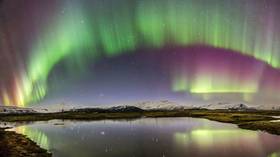Escaping MARTIAN WATER creates ‘proton auroras’ which may unlock mystery of planet’s missing oceans

New research into the vast hydrogen cloud around Mars has found that so-called ‘proton auroras’ are far more common than previously thought and may unlock the mystery of how Mars lost its oceans and rivers.
The new study found that the proton aurora, first spotted in 2016 by NASA’s MAVEN (Mars Atmosphere and Volatile EvolutioN) mission, is the most common form of aurora found on Mars and may help further humanity's understanding of climate change on the planet and, more specifically, the rate of water loss into the vacuum of space.
Also on rt.com Water on Mars PICTURED: ESA shares incredible IMAGES of Martian ice craterThese auroras sweep across the skies above the dusty plains of the Red Planet, though unlike the aurora borealis back here on Earth, future colonists will need ultraviolet goggles to see them.
Proton auroras occur when solar winds lash against the vast hydrogen cloud in orbit around Mars, with the positively charged solar protons being neutralized as they take electrons from the hydrogen atoms, emitting UV light in the process.

Martian water loss into space helps create the hydrogen cloud, so scientists could now have a way to measure water loss over time and calculate just how wet the planet may once have been, while also unlocking what caused such a catastrophic shift in its climate.
“Through this research, we can gain a deeper understanding of the Sun's interactions with the upper atmosphere of Mars and with similar bodies in our Solar System, or in another solar system, that lack a global magnetic field,”says physicist Edwin Mierkiewicz of Embry-Riddle Aeronautical University in Florida.
Based on this new research, proton auroras appear in 14 percent of daytime observations made by NASA's MAVEN spacecraft but this figure jumps to 80 percent of observations carried out during the southern summer on Mars, when it is closer to the sun.
The increased dust and heat of summer causes water vapor to be lifted out of the atmosphere by vast, continent-sized dust tornadoes. The water vapor is split into hydrogen and oxygen by the Sun's radiation, eventually forming the vast hydrogen cloud in the atmosphere.
Also on rt.com Gargantuan ‘dust towers’ may have STRIPPED Mars of all its water, says NASAWhile the findings have yet to be peer-reviewed, they nonetheless provide a fascinating insight into our most-likely candidate planet for colonization.
“Perhaps one day, when interplanetary travel becomes commonplace, travellers arriving at Mars during southern summer will have front-row seats to observe Martian proton aurora majestically dancing across the dayside of the planet, while wearing ultraviolet-sensitive goggles, of course,” said planetary scientist Andréa Hughes, also from Embry-Riddle Aeronautical University.
Like this story? Share it with a friend!














